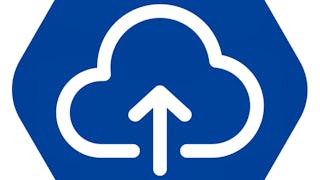Microsoft Azure is a service created by Microsoft to provide cloud computing for creating and managing applications and services using a cloud environment. Azure provides software as a service (SaaS), platform as a service (PaaS) and infrastructure as a service (IaaS). The platform supports many programming languages and frameworks and can be used alone or in a multi-vendor cloud environment.



(51 reviews)
What you'll learn
Configure and manage Azure subscriptions
Create and manage resource groups and identities
Configure and manage storage and backups
Create and manage virtual machines and virtual networks
Skills you'll gain
- Role-Based Access Control (RBAC)
- Virtualization
- Virtual Private Networks (VPN)
- Data Migration
- Cloud Infrastructure
- Cloud Storage
- Virtual Machines
- Multi-Factor Authentication
- Disaster Recovery
- Network Infrastructure
- Identity and Access Management
- Microsoft Azure
- Infrastructure Security
- Azure Active Directory
- Infrastructure As A Service (IaaS)
Details to know

Add to your LinkedIn profile
7 assignments
See how employees at top companies are mastering in-demand skills

There are 8 modules in this course
This module is an introduction to the course. It will introduce the instructor and the topics that will be covered. Then it will guide the student into creating a new Azure subscription to use in the course.
What's included
2 videos
Our journey begins with learning about the subscription and how to manage it. The subscription is the building block for all that we do in Azure. So, we need to understand what it is and how it is used. We will first take a look at the resources and resource groups. Then we will explores the permissions structure that is used to secure Azure resources. Then we are introduced to the first tool that is the Azure Monitor. We will look at creating alerts and also analyzing data using Log Analytics. Then we look at how we can configure additional diagnostics to help us make more informed decisions in designing the Azure environment.
What's included
13 videos6 readings1 assignment1 discussion prompt
Now that we have a foundation for Azure we need to delve a little deeper into security. In this module we will be looking at how to use RBAC (Role-Based Access Control). We will be look at working with Azure roles and how to configure access to Azure resources. We will also talk about creating custom Azure roles. Then we discuss using Azure policy to prevent project sprawl and also to protect the Azure environment.
What's included
10 videos5 readings1 assignment2 discussion prompts
When working with Azure we are using identities. These are housed in Azure AD and also on-premises Active Directory Domain Services (AD DS). In this module, we will examine Azure AD and contrast it with AD DS. Also, we will look at the tools that are involved in creating a Hybrid Azure AD environment. The discussion would not be complete without talking about how to secure the environment and using MFA. Plus, we need to understand the different editions of Azure AD, so we will be exploring this topic also.
What's included
11 videos4 readings1 assignment1 discussion prompt
Storage is very important in Azure. Without storage then Azure would not exist. There are several different aspects of storage that we need to understand. We look at each of these different concepts. Things like the storage account, replication , lift/shift and so much more.
What's included
25 videos6 readings1 assignment2 discussion prompts
The basis of an Azure environment is the VNET. This concept is not that hard to grasp. You need to understand the different types of connections that are available with the VNET. How do we communicate and the configuration? There are a lot of concepts that you need to understand to work with Azure VNETS. We will explore each of those concepts in depth.
What's included
17 videos7 readings1 assignment1 discussion prompt
So, you start off with the subscription, you configure some security, you acquire the storage, you build your VNETS and now it is time to explore VMS. If you have worked with hyper-visors in the past this will be your wheelhouse. Azure is backed by Hyper-V. We can support Windows and Linux VMS. We can make them highly available and also resilient. We can back them up and also provide DR. These are the concepts that you will learn about in this Module.
What's included
15 videos5 readings1 assignment3 discussion prompts
Ok, this is your final exam. All of your effort is now going to be tested. This will gauge how well you have grasped the material over the last couple of weeks. Good Luck. We know that you will do well.
What's included
1 assignment
Earn a career certificate
Add this credential to your LinkedIn profile, resume, or CV. Share it on social media and in your performance review.
Instructor

Offered by
Explore more from Computer Security and Networks
 Status: Free Trial
Status: Free Trial Status: Free Trial
Status: Free Trial

LearnQuest
Why people choose Coursera for their career




Learner reviews
51 reviews
- 5 stars
50.98%
- 4 stars
15.68%
- 3 stars
11.76%
- 2 stars
1.96%
- 1 star
19.60%
Showing 3 of 51
Reviewed on Jun 22, 2021
Good and challenging course. The labs and quizzes have minor issues with typos and missing download links. Overall, I had a lot of fun reviewing my Azure knowledge.
Reviewed on Sep 15, 2020
This course had provided good practical and functional knowledge of the Azure subject and well cover the key operational topics.
Reviewed on May 3, 2021
The course has really been helpful in gaining azure fundamentals
New to Computer Security and Networks? Start here.

Open new doors with Coursera Plus
Unlimited access to 10,000+ world-class courses, hands-on projects, and job-ready certificate programs - all included in your subscription
Advance your career with an online degree
Earn a degree from world-class universities - 100% online
Join over 3,400 global companies that choose Coursera for Business
Upskill your employees to excel in the digital economy
Frequently asked questions
Access to lectures and assignments depends on your type of enrollment. If you take a course in audit mode, you will be able to see most course materials for free. To access graded assignments and to earn a Certificate, you will need to purchase the Certificate experience, during or after your audit. If you don't see the audit option:
The course may not offer an audit option. You can try a Free Trial instead, or apply for Financial Aid.
The course may offer 'Full Course, No Certificate' instead. This option lets you see all course materials, submit required assessments, and get a final grade. This also means that you will not be able to purchase a Certificate experience.
When you enroll in the course, you get access to all of the courses in the Specialization, and you earn a certificate when you complete the work. Your electronic Certificate will be added to your Accomplishments page - from there, you can print your Certificate or add it to your LinkedIn profile. If you only want to read and view the course content, you can audit the course for free.
If you subscribed, you get a 7-day free trial during which you can cancel at no penalty. After that, we don’t give refunds, but you can cancel your subscription at any time. See our full refund policy.
More questions
Financial aid available,





